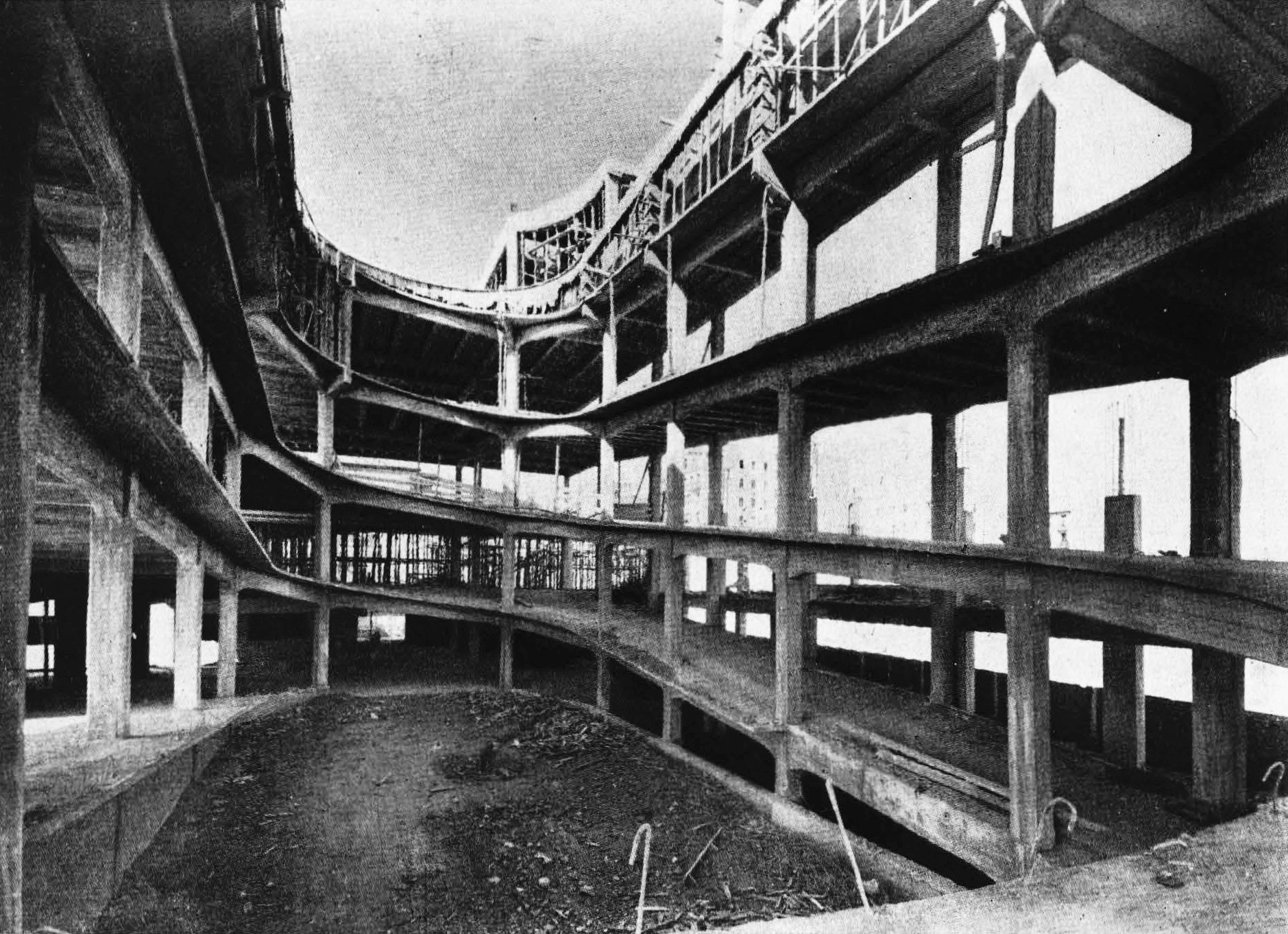The PME is inserted in the urban complex, conceived as a small self-sufficient city with its own sports, commercial, school, recreational and religious facilities. The PME complex is made up of 3 volumes: A main building that face to Cea Bermúdez Street (with five floors, a roof and a basement), composed of a volume of offices to the West and the ramp to the East, and another two larger developed perpendicular to its rear. The one to the west is a large open-plan warehouse dedicated to a single-floor spare parts workshop and the second building, with three floors plus covered, is dedicated to parking (for 1,000 cars), and connected to the ramp of main building. In addition, under the entire complex and below the basement there is a shelter or bunker.
Particularly noteworthy architectural pieces are, the two-way ramp (the only one in our country), its currently transformed roof, the mural entitled "Automobile trades", the concrete structure of the parking lot, or the workshop; a large open-plan floor of10,000 square meters, the largest of these characteristics in Spain, with a very interesting shape saw roof.
Inside the PME workshops there is an impressive mural, already mentioned, entitled "The Trades of the Automobile" that Germán Calvo painted in 1951 (in an alarming state of conservation), following the line marked by those painted during the 1920s and early 1930s, by Mexican muralists, especially Diego Rivera at the Ford and General Motors factories in Detroit. The mural is 26 meters long by 1.6 high, it is impressive to see it inside the workshops, although unfortunately it is not very well preserved.
Finally, a curious part is the part enabled in one of the workshop areas where we can contemplate old objects, tools and machinery, spaces that recreate part of the park's rooms in its beginnings, such as a doctor's office, a barber shop or a corner for drivers to rest and, for car lovers, a vehicle exhibition.

Detail of the ramp. Parque Movil del Estado by Ambrosio Arroyo Alonso. Image from the Revista Nacional de Arquitectura, 1951 (no. 113, p.10).
Description by Ambrosio Arroyo Alonso(2):
Circulation.- It has two completely different facets, but essential in this type of building: the circulation itself and the control and surveillance. Therefore, except in exceptional cases, all access, both for vehicles and for workers, employees, visitors, etc., is unique, just as the normal exit of vehicles is unique.
The most common car access is that of vehicles that are parked or locked in the garage. If it is on the ground floor, the access is direct and without crossing of any species, and if it is on the upper floors, they go up to the corresponding one by the ramp dedicated solely and exclusively to access.
Once the vehicle is in its garage floor, the circulation inside it is always in one direction only, and its parking, which is arranged with an inclination of 75 °, is verified by a simple reversing maneuver, each vehicle being tracked laterally by curbs that compartmentalize the garage and that act as a stop at the rear.
The exit of the vehicles, always in one direction, does not present any problem; on the ground floor it is equally direct and on the remaining floors you just have to take the special downward ramp and you will find yourself directly at the exit door where the control is available. If the vehicle arrives damaged and goes to the workshop, it only has to be located in the intermediate street that forms between the workshop and the garage. If the vehicle is to be greased or washed, it will go to the ground floor, where there are washing tunnels and greasers for this purpose, so that its circulation is directly resolved.
The workshop, with its characteristics and function, is developed on a single floor.
Foundation. By reinforced concrete footings, in the part corresponding to the structure of this material, and running from brick factory to workshop and semi-basement and by stepped pillars in straight feet, made of iron.
Structure. Of reinforced concrete in general services, ramp and garage, and mixed brick and metal in workshop and ramp cover.
Masonry. Uncovered, in facades and walls of garage and workshop enclosure, in the latter, solid throughout its thickness, and in the rest, with an air chamber and partitions. In the central courtyard and dividing walls, the walls are plastered.
Framework floor. Made of ribbed concrete slab in semi-basements and workshop: the floor is placed directly on a concrete slab."
NOTES.-
(2). Ambrosio Arroyo. “Parque Móvil Ministerios, Madrid”. Madrid: Revista Nacional de Arquitectura, 1951 (núm. 113, pp. 5-10).
BIBLIOGRAPHY.-
- Dolores Henar González Chico, Manuel Pons Carlos-Roca. «EL PARQUE MÓVILDEL ESTADO. 80 años de servicio público a través de la movilidad.» Madrid: Ministerio de Hacienda y Administraciones Públicas. Parque Móvil del Estado, 2015.
- Pedro Navascués Palacio. Report of the Real Academia de Bellas Artes de San Fernando, requesting the opening of the BIC file, signed by Pedro Navascués Palacio, June, 2018.
- AAVV. Base report to request the BIC declaration for PMM Madrid. AAVV, December 2018.









































![10 Architecture Studios Led by women [XII] 10 Architecture Studios Led by women [XII]](/sites/default/files/styles/mopis_home_news_category_slider_desktop/public/2025-03/metalocus_10-arquitectas-xi_01b.jpg?h=3b4e7bc7&itok=KFjWtS5J)















